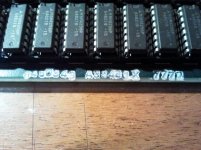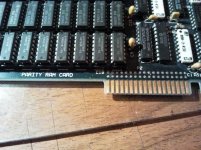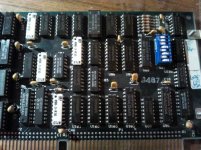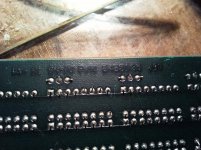Hello everyone,
I have this old ISA card sitting in my shelves for years now, and no idea how to make it work, despite my noble efforts . The difficult thing is, the marks on the card don't help much, at least for me
. The difficult thing is, the marks on the card don't help much, at least for me  . In fact, this thing is unknown to the entire world, if you google it, you find a post of another guy asking for info, and nobody answered.
. In fact, this thing is unknown to the entire world, if you google it, you find a post of another guy asking for info, and nobody answered.
As you can see, the only thing written on it is "Parity ram card", plus some id numbers, like "W5 500". The card comes from 1987, it has four banks of 18 chips each, and a dip switch on the right.
My thought is that it might be an expansion card for an OEM PC, probably Olivetti, since it has quite a number of memory onboard and there are no marks on it except part numbers. Maybe belongs to a M290?
Obviously, the card doesnt work on its own, but the IC's heat up when running on a PC, so it's probably working. It's very well preserved, no oxidation etc, looks new.
Do you have any idea to id the card?
Needless to say, my goal or mission impossible (depens on how you see it :D) is to make it work on a 286 system undergoing restoration.
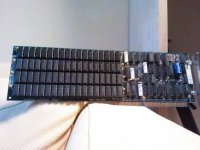
I have this old ISA card sitting in my shelves for years now, and no idea how to make it work, despite my noble efforts
As you can see, the only thing written on it is "Parity ram card", plus some id numbers, like "W5 500". The card comes from 1987, it has four banks of 18 chips each, and a dip switch on the right.
My thought is that it might be an expansion card for an OEM PC, probably Olivetti, since it has quite a number of memory onboard and there are no marks on it except part numbers. Maybe belongs to a M290?
Obviously, the card doesnt work on its own, but the IC's heat up when running on a PC, so it's probably working. It's very well preserved, no oxidation etc, looks new.
Do you have any idea to id the card?
Needless to say, my goal or mission impossible (depens on how you see it :D) is to make it work on a 286 system undergoing restoration.

Last edited:


